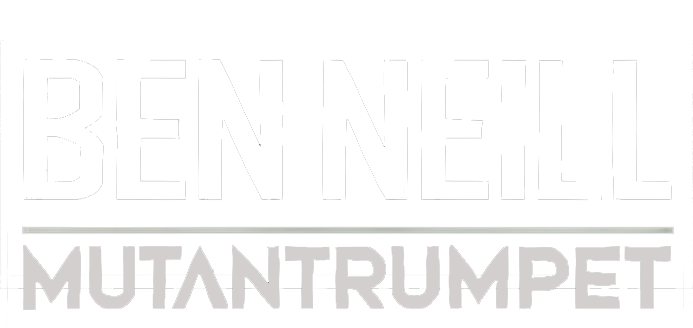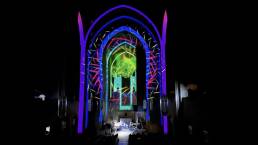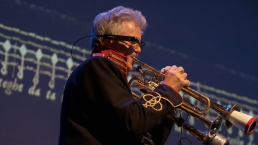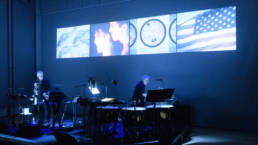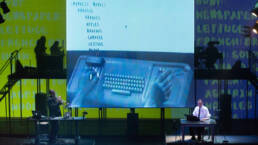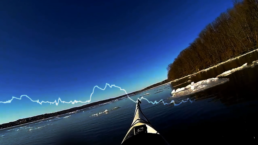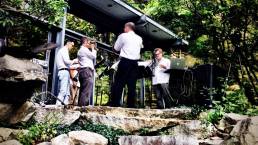Performances
Mutantrumpet Live 2025
Ben Neill creates unique musical and visual experiences that blur the lines between acoustic and electronic music performance, ambient textures and grooves, and live interactive video. In Neill’s live performances, the acoustic sounds of his multi-belled instrument are sampled in real time and processed using custom software that interfaces with his notes, dynamics, and 28 onboard controllers; joysticks, distance sensors, switches, and potentiometers. The system enables him to control digital audio as well as live interactive video. , which is managed and mapped by VJ Dolphin Uppercut Avenger. The visual components of his performances include imagery by a variety of artists including chaos mathematician/psychedelic philosopher Ralph Abraham, filmmaker Chrystel Egal, and digital artist Carl van Brunt.
Fantini Futuro
Fantini Futuro (2019) is an electronic opera by Ben Neill for the Mutantrumpet, countertenor, Baroque keyboards, and interactive video projections. The immersive piece is based on the music and life of early Baroque trumpeter/composer Girolamo Fantini, who was responsible for bringing the trumpet indoors from the hunt and the battlefield to the realm of art music. Using an array of interactive technologies, Fantini is depicted as a traveler through space and time by a synthesis of early music, minimalism, and digital media performance. Fantini’s translocation of the trumpet is mirrored and reimagined by Neill’s Mutantrumpet, which extends the acoustic instrument into the virtual realm.
ITSOFOMO / David Wojnarowicz
ITSOFOMO (In the Shadow of Forward Motion) is a multimedia performance collaboration created by artist David Wojnarowicz and composer/musician Ben Neill in 1989. Integrating music, text, and video in a multi-dimensional format, the work embodies the act of acceleration and its sensory manifestations. It is through this frame that Wojnarowicz addressed the accelerating AIDS crisis and the politics of AIDS in the United States at that moment. ITSOFOMO is a fierce meditation on history and power.
The Demo / Mikel Rouse
The Demo (2015) is a music theater work written by composer/performers Mikel Rouse and Ben Neill based on Douglas Engelbart’s historic 1968 demonstration of early computer technology. Performances have been presented at the University of Illinois Krannert Center, Bing Concert Hall at Stanford University, and the University of Kansas Lied Center.
Engelbart’s 1968 demo rolled out virtually everything that would define modern computing; videoconferencing, hyperlinks, networked collaboration, digital text editing, and something called a “mouse.” The Demo re-imagines Engelbart’s historic demonstration as a technologically-infused music theater piece, a new form of hybrid performance.
La Monte Young / The Second Dream
Neill began working with La Monte Young in 1984 as a student of composition and Indian classical music after being introduced by Jon Hassell. He worked closely with Young to develop The Melodic Version of The Second Dream of the High Tension Stepdown Line Transformer, and has led many performances of the piece as well as other works by Young for four decades
Fathom: Hudson River Data as Music
Fathom is an audiovisual performance piece created in 2016 by composer/performers Ben Neill and Mimi Goese in collaboration with the Beacon Institute for Rivers and Estuaries (BIRE) of Clarkson University. The work is scored for Neill’s self-designed electro-acoustic Mutantrumpet and Goese’s voice with interactive computer audio and video.
Neill and Goese were commissioned by BIRE to create a musical piece based on BIRE’s Hudson River environmental data collected during Hurricane Sandy, and received a New Music USA grant for its creation. Using a variety of computer software, Fathom directly translates the chaotic structures of the natural environment into a work of multimedia art.
Manitoga
MANITOGA (2014) is composed for a unique brass ensemble of the mutantrumpet and an ensemble of four players using conceptual artist Carol Szymanski’s brass sculptures/ musical instruments which she calls phonemophones. Each phonemophone forms a letter of the alphabet in a font of her design and producing a unique range of tones. The eight phonemophones used in the piece spell the word MANITOGA. Commissioned in 2014 by Manitoga, The Russel Wright Design Center, MANITOGA was created for the unique setting of Wright’s home and landscape in Garrison, NY, and with his ideas on the harmony between design and nature in mind.
